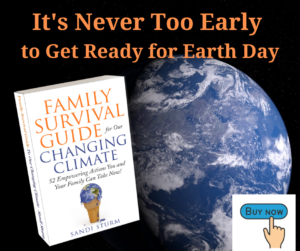Everything you do and every purchase you make has a carbon footprint. What does that mean?
Look around you right now. You probably see dozens of “things.” But let’s explore the footprint of a book.
The life cycle of a book starts in the forest. A timber company owns some land and sends someone out to determine what trees to extract. Big diesel powered equipment fell the trees and then transports them to the mill. Fossil fueled equipment chips the wood and turns it into pulp. The pulp is then turned into paper. The paper is put onto large rolls and sent to the printers where it is processed into a book using inks and glues. When the books are printed, they are shipped off to a distributer and eventually end up in a store or your mailbox.
Every step in the process uses energy in the form of electricity, fuel for transportation, and a lot of water. That is an abbreviated carbon footprint of a book.
Now look around you again. You may see things made of fabric, steel, plastic, or wood. What was the journey to get to you?
If you think of the carbon footprint of items before you buy, it just might change your purchasing habits, which really puts the consumer in a position to greatly reduce emissions that are causing the climate crisis.
Here are four things you can consider right now:
1. Experiences instead of stuff
Is your calendar full of birthdays, anniversaries and holidays that require you to buy a gift for a family member or friend? Many times, this leaves us scrambling to find a last-minute treasure. And sometimes we may just draw a blank on what to get them because they already have everything.
My parents always fell into that category. But I knew they loved trains, so when they would fly in to see us in Southern Utah, I had them fly into Denver and we bought them a train ticket through the Rockies. They never forgot those trips. One year we rented a houseboat on Lake Powell, and on one Mother’s Day, mom (she was 80 at the time) and I flew in a small plane around Mt. McKinley!
How about trying an experience instead? Here are some ideas to get you started.
- Gift Certificate to a great local restaurant – suggest that you all go together so you can make a nice memory, instead of them stuffing that new blanket, you though they would like, into the closet.
- Yearly pass to local amusement park – this will go far if the family has young children. It may even bring the kid out of the elders too. You can’t buy that at the store.
- Seasonal Pass to your local performing art center, outdoor concert series, or wine tour.
To Do: Take out your calendar and see what gift giving events you have over the next year. Now, what experiences could you give to them instead of stuff?
2. Carbon Conscious Night Out
This one is for those who like an occasional beer at the local pub. But did you know that going to a local brewery can reduce your carbon footprint? Think about it. The beer is made on site. It is put into kegs that are wheeled into the next room, not put into trucks, and taken all over the country. The draft beer is poured into reusable pint glasses and walked over to you and your friends.
Having a party? Why not get a little keg of local brew instead of cans and bottles? The carbon footprint of glass and aluminum is large even if you do recycle.
To Do: Where are the local breweries near you?
3. Just Park Already
Entering a busy parking lot can be quite stressful. It is also opportunity to waste fuel and put more CO2 into the air. You see people driving in circles looking for that perfect spot or idling in place for several minutes waiting for someone to pull out.
This may not be your practice, but you know that others do it all day every day in grocery store parking lots around the country.
The US Department of Energy suggests that idling more than 10 seconds uses more fuel and produces more emissions that restarting your engine. Think of other instances where you may be idling for longer periods.
A less stressful plan is to park out in the open spaces every time. It is easier to pull in and park and also leave without dodging the people at the door. This is also helpful if you drive an electric vehicle because every foot counts!
To Do: Identify the perfect space that seems to be empty most of the time and steer your vehicle there instead of the front door.
4. Go on a Picnic
How many times have you caught yourself asking the question, “where should we go for lunch?” Our thoughts go to fast food or restaurants, but why not pull out the picnic basket instead?
You can make a basket out of anything. Fill a bag or any container with non-breakable containers, plates, and cups so they are at the ready. Put in things you may need like salt and pepper and napkins.
Going on a picnic can save you money, reduce waste, and provide an experience to be cherished. Maybe you go to a local park or have it ready when you stop at a rest area on a longer journey. It will taste much better than a gas station hot dog!
A report from Science Daily stated that living close to nature and spending time outside has significant and wide-ranging health benefits. Exposure to green space also reduces the risk of type II diabetes, cardiovascular disease, premature death, preterm birth, stress, and high blood pressure.
To Do: Gather things you have around the house and create a picnic basket. While you are at it, where can you go on your first picnic?
When you head out on your picnic, remember to grab your Radiate Portable Campfire, and maybe something to warm over the fire. It is made from sustainable products and recyclable at the end of its life. S’mores anyone?









